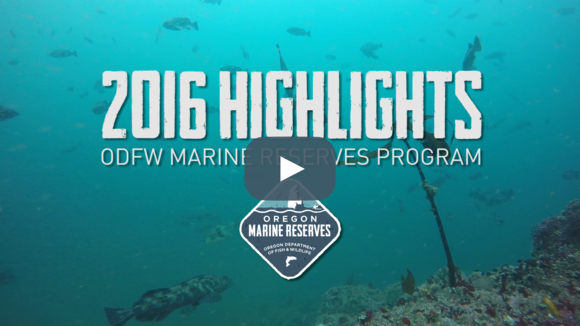|
In today’s newsletter we are taking a look back at 2016 and are featuring some of our top stories from the past year. There's also an infographic highlighting ODFW Marine Reserves Program accomplishments in 2016. You’ll also find our annual Fish On! Hook-and-Line Newsletter (including some results from last year's surveys).
Top Stories of 2016
 Click on the video above to view
From underwater video research, to social science surveys, bird studies and collaborations with fishermen – here’s a look back at the ODFW Marine Reserves Program’s top stories of 2016:
- The old stereotype of researchers wearing white lab coats hearkens to a bygone era that has given way to a new and collaborative form of science. This science involves swapping lab coats for boots, waders … and a fishing boat. Read more about our collaborations with commercial fisherman, Jeff Miles …
- We did a series of stories stemming from our human dimensions research program. We learned that Oregonians have very different perceptions of marine reserves, depending on where they call home. “A Fishing Perspective” examined some of the effects of marine reserves on the fishing community in Garibaldi, Oregon. And if you’ve ever wondered who is visiting the marine reserves and why, this was the basis for a human dimensions study that we reported on just this past November.
- Beyond the research being conducted by the ODFW Marine Reserves Program, marine reserves have attracted additional research that is helping us learn more about the nearshore ecosystem. We highlighted some of this research being conducted on seabirds and ocean acidification. “For The Birds” examined 3 seabird studies on the central Oregon Coast led by Oregon State University, the Audubon Society of Portland, and ODFW. Seabirds are an important ecosystem component and the central Oregon coast is a hotspot for seabird nesting. “Souring Seas” covered efforts by Oregon State University, Surfrider Foundation, and local volunteers to better understand, and educate people via citizen science, about ocean acidification.
- Underwater video research is a large component of our ecological monitoring work. We had a series of stories that covered video research, including why we use underwater video in our research. We even captured an upwelling event on camera – read, “Plankton’s Playground, ” to find out and see what actually happens during this annual oceanic event! We also highlighted the dual “stereo” camera systems we are testing to see if we can more accurately determine fish lengths in some of our surveys.
- Marine reserves depend on enforcement and compliance, otherwise they are simply “paper parks” with lines on a map. The compliance rates have been relatively high among Oregon’s reserve sites. See “What’s Working,” to learn more about enforcement efforts.
 |
2016 Highlights
Check out our infographic highlighting some of the ODFW Marine Reserves Program accomplishments in 2016. With 10 human dimensions studies completed, 3 scientific journal publications, multiple outreach events, and 8 ecological monitoring studies - it was a busy year!
Click the image above to view the full infographic
Fish On! Hook-and-Line Newsletter
The 2016 hook-and-line surveys were a great success thanks to our volunteer anglers and boat captains and crews. We were able to collect data from 2,855 fish during 18 fishing trips in the spring and fall of 2016. This was the 4th year of surveys at Cascade Head, the 3rd year at Cape Perpetua and the 2nd year of longlining at Redfish Rocks.
Take a look at the 2016 Hook-and-Line Newsletter for more information about species caught, plus our comparison of two different gear types that produced very different results...
Click the image above to access the full newsletter
See More Oregon Marine Reserves News
|